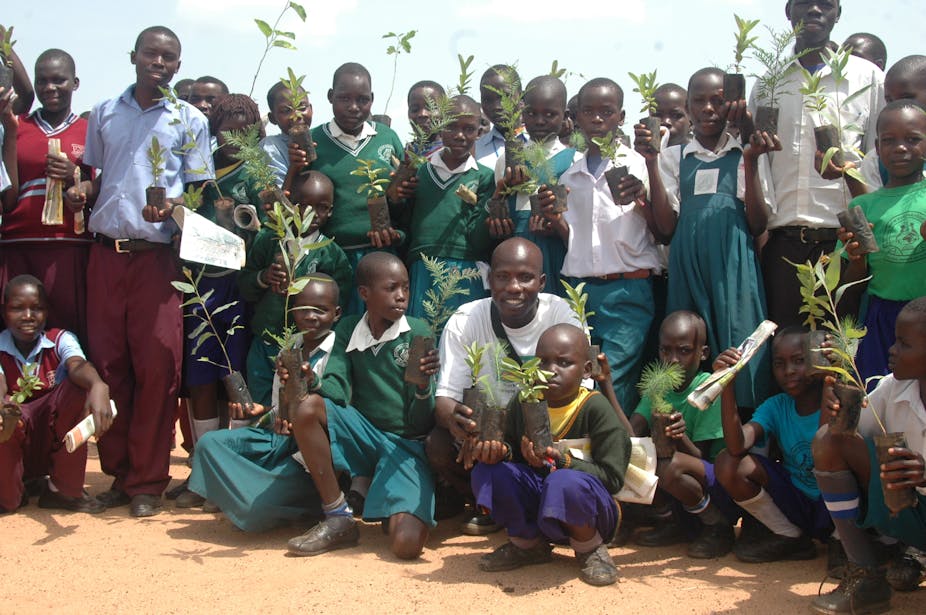Otim Joseph first started planting trees to protect his mother and sisters from being raped.
Growing up amid a civil war, he watched as the Ugandan army cut down swathes of forest to make it easier to hunt rebel Lord’s Resistance Army soldiers - with devastating consequences for local women and girls.
“This meant that women had to walk to bushland, in some cases up to 10 kilometres away from their own communities, to collect firewood. This is when they would be raped.”
In his early 20s, Otim began collecting seeds from native trees to restore the forests on the post-war landscapes. He then started a nursery that now has more than 400,000 seedlings, mostly African natives, such as Cassia, Luciana and Markhamia. He donates these to schools, community groups and even the army.
The seeds he plants are no longer just about providing trees for shelter, but also timber, logs for fuel, food and herbs.
Good news amid gloom
Otim, now a 29-year-old forest supervisor for Uganda’s National Forestry Authority, was one of 1200 delegates to share his story at the first Global Landscapes Forum, held alongside the latest UN climate talks in Warsaw, Poland.
One of the few positive outcomes of the Warsaw talks was the agreement on rules for financing forest projects in developing nations, along with US$280 million pledged by the US, Britain and Norway to a World Bank-led forest fund.
The Global Landscapes Forum heard countless stories like Otim’s, about how communities worldwide are trying to tackle complex problems like illegal logging and forest restoration, often in places with growing populations and multiple demands on the land.

Lindiwe Sibanda from the Food, Agriculture and Natural Resources Policy Analysis Network, shared agriculture success stories from west Africa, where farmers are driving natural regeneration of vegetation while also improving their corn crop yields to 500 kg per hectare.
But despite such positive stories, there is still much to do, and Sibanda was among many to express concern about UN climate negotiations ignoring agriculture. “We are all guilty because we are participating in a process that does not include agriculture,” she said. “Over 800 million people do not have access to food and a further 2 billion suffer from malnutrition.
"We can’t feed 9 billion without climate-smart agriculture or without our forests. They are part of the solution for climate change and if we don’t fight to have them included in a climate deal, then we are guilty. This is the greatest challenge of our time.”
Farms vs forests
Expansion of agricultural land drives 80% of the world’s deforestation and forest degradation. This is particularly true for the poorer tropical forest regions of Latin America, Asia and Africa, which are also striving to cope with rapidly increasing populations.

Deforestation is estimated to contribute between 10-15% of all human-caused greenhouse gas emissions.
And the current international approaches to reducing rising emissions from deforestation and agriculture are not working well enough.
As the World Bank’s Vice President for Sustainable Development Rachel Kyte told the forum, if the world continues “to fund crop expansion on one hand but forest protection on the other, we are simply wasting taxpayers’ money”.
Local responses to global problems
One of the main international forestry schemes discussed at the forum was the the Reducing Emission from Deforestation and forest Degradation (REDD+) program, which pays poor countries like those in the three major tropical forest regions — the Amazon Basin, the Congo Basin, South East Asia – to protect their forests.
Indonesia has a target to reduce its carbon emissions by 41% by 2020 and it sees REDD+ as a key tool for achieving this. The Indonesian President has created a decree that REDD+ be high priority and has appointed a special agency answering directly to him.
Agung Wicakson from that agency told the forum in Warsaw that Indonesia’s forests faced “huge land use conflicts between mining, agriculture and forestry”, especially in places like Kalimantan.
But looking beyond tropical forests, an equally big challenge is to make the most out of degraded farm land.
Sara Scherr, president of Ecoagriculture Partners, described how 450 small groups in Ethiopia have been using smarter farming practices in Ethiopia to restore grass cover and highly degraded landscapes, and enrich the soil.
“This has meant their reliance on food aid has declined, and they have access to better water,” she said. “The land is now also becoming a carbon sink.”
There are hundreds of other small projects like that happening in Latin America, Madagascar and Brazil, Scherr said. “These projects are seeking to control deforestation, restore lands, and reduce fire use while still being able to provide sufficient food.
"Our current agricultural production models are 150 years old,” she said. “We need to look at managing the whole set of resources. This requires a transformation.”
In each case, every big change requires someone to plant the first seed - as Otim Joseph is continuing to do in Uganda with help from a new generation: “If children see me planting the trees, then they are inspired to plant their own trees.”
* Alison Binney contributed interview material and photos for this article.

